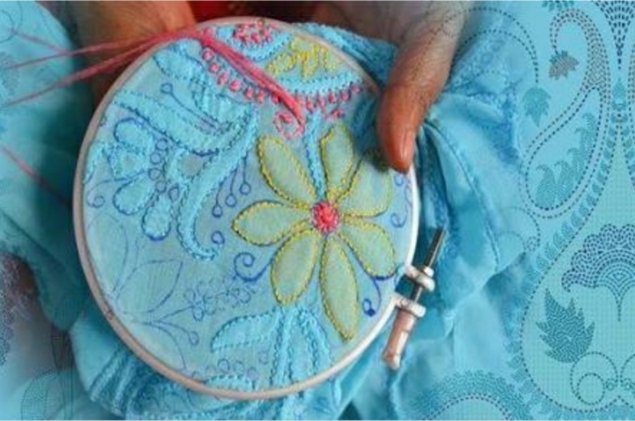Lucknow Chikan craft is a 400-year-old craft, and the technique of its creation is called Chikankari work. It originated in Persia and came to India through the works of the craftsmen. The word“chikan” means embroidery and this art includes 36 different stitching techniques -often a combination of pearls, mirror andmukaish (traditional Lucknow Embroidery). In older times, it was done on muslin cloth but today it has gained popularity in North India with its hub and origin in Lucknow. Some historian says that its creation can be traced backto 3rd century AD during the reign of Chandragupta Maurya but its exact origin remains a mystery for us. It is said that the Mughal Emperor Jahangir had a wife named Noor Jahan who was a talented embroiderer of Chikankari work. Jahangir also liked this embroidery and established several workshops to sell the product. Chikankari work does not consist of floral pattern rather it has strong influence of flowers in its designs.In primitive days, it consisted of pure needle work on soft cotton cloth. It was done by white thread on white cloth, but today the work is available in various colours on different fabrics. It is used on Kurtas, Saris, Salwar suits, Table covers etc.
The Chikankari craft was accorded the Geographical indication tag in December,2008. The GI Tag has brought significant changes to this kind of work. This craft belongs to the unorganized sector;the tradition skill of the artisanhas played an important role in protecting our cultural heritage. It has also employed many people. This work is done by 5 process;
- Cutting- Cutting of clothes in required shapes.
- Printing- The cloth is then printed with colours.
- Embroidery- After printing the cloth, embroidery is done on the coloured cloth.
- Washing- It is the most important process after embroidery, the cloth becomes so dirty hence it gets washed.
- Finishing- It includes extra threading, stitching and then it is completed.
Some of the famous Chikankari work is:
- Keel Kangan– In this stitch petals and florals motifs are used on the clothes.
- Bakhiya– In this filling is done on the wrong side, design is done by running stitch on the right side of the fabric.
- Tepchi– It is darning stitch done with 6 strands on the right side of the cloth.
- Badla– In this type of stitch, the stem is wrapped horizontally with small stitches. It is used to make veins of the flowers.
There are many types of stitches which have been used to make this craft which makes them more attractive. Chikan has changed from theprofessional activity of men to cottage industry for women. All the work from painting to washing are done by men except the work of embroidery which is done by women. The government wants to promote their work and protect its cultural heritage. A piece of good work takes a long time to come. There are 36 kinds of stitches used in this work which are quite appreciable.
The major problems for artisans in this field is that they are uneducated people, living in unhygienic conditions, not given adequate price for their work. This unorganized sector has highly exploited and under paid workers. The Government should come up with certain guidelines to protect these artisans from exploitations. They should work in partnership with the private sector to encourage and provide support for services like local centres for skill training, vocational training etc. The GI tag has increased the visibility of the product and increased its revenue.
Priya Singh @Samacharline

